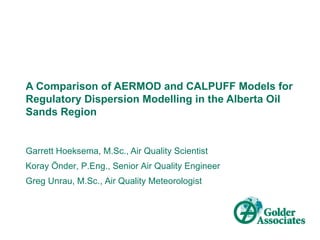
CALPUFF versus AERMOD comparison
- 1. A Comparison of AERMOD and CALPUFF Models for Regulatory Dispersion Modelling in the Alberta Oil Sands Region Garrett Hoeksema, M.Sc., Air Quality Scientist Koray Önder, P.Eng., Senior Air Quality Engineer Greg Unrau, M.Sc., Air Quality Meteorologist
- 2. Outline Background Methods Results Summary Questions 2
- 3. Background Air Quality modelling To get ground-level concentrations based on what is being input into the atmosphere from emissions sources Many different models to choose from in order to obtain the ground-level concentrations AERMOD, CALPUFF, SCREEN3 Air quality models are sensitive to: Input Meteorological Data Model Switches The purpose of this study is: 1. Effect of different model switches or different meteorology on individual models 2. Compare predictions from different models 3
- 4. Background – Air Dispersion Modelling AERMOD Steady-state plume dispersion model designed to predict near field CALPUFF Lagrangian Gaussian puff dispersion model for both near and far field applications Both AERMOD and CALPUFF have been approved for regulatory modelling in Alberta, including near field CALPUFF has historically been used in the oil sands region It can handle regional emissions and predict potential acid input Experience shows that for certain pollutants and for distances less than 10 km, results can vary considerably between the two models 4
- 5. Methods CALPUFF and AERMOD runs were performed for various types of emission sources Steam Generator (30 m) Glycol Heater (9 m) Incinerator (100 m) Flare (90 m) Area Modelling was performed for SO2 Unit emission rate of 1 g/s used The point source was placed in a valley to observe how each model handles terrain features Stack characteristics were chosen based on those typical for the type of source found in the oil sands industry 5
- 6. Methods CALPUFF model runs Two CALPUFF runs were completed utilizing two different model settings for each run 1. U.S. EPA default model settings were used 2. Alternate model settings were used (based on BC and Ontario modelling guidelines) Parameter CALPUFF Run 1 CALPUFF Run 2 MDISP 3 – PG coefficients 2 – internally (rural) and MP calculated coefficients coefficients (urban) MPDF 0 – does not use PDF 1 – uses PDF for for dispersion dispersion 6
- 7. Methods AERMOD model runs Three AERMOD runs were completed based on different meteorological data Meteorological AERMOD Run 1 AERMOD Run 2 AERMOD Run 3 data Upper Air Data MM5 MM5 MM5 meteorological meteorological meteorological data data data Surface Air Data MM5 Fort McMurray and Fort McMurray and meteorological Mannix Tower low Mannix tower all data level only (20 m) levels (20 m, 45 m, 75 m) 7
- 8. Results Source Averaging Period CALPUFF CALPUFF AERMOD AERMOD AERMOD Run 1 Run 2 Run 1 Run 2 Run 3 Steam 1-hr 1st highest [µg/m³] 13.0 11.9 12.6 15.0 17.5 Generator 1-hr 9th highest [µg/m³] 4.7 4.3 9.4 11.7 11.0 Stack height = Distance -direction 1.7 km 0.2 km 1.6 km 1.5 km 1.5 km 30 m NNE NE ENE E E 24-hr 1st highest [µg/m³] 1.6 2.4 2.7 2.7 2.4 Annual [µg/m³] 0.06 0.13 0.15 0.16 0.10 Glycol 1-hr 1st highest [µg/m³] 62.7 47.8 58.0 60.8 124.9 Heater 1-hr 9th highest [µg/m³] 27.1 35.0 49.4 36.9 44.2 Stack height = Distance -direction 1.5 km 0.1 km 0.1 km 1.8 km 0.9 km 9m NNE NNW NNW S ENE 24-hr 1st highest [µg/m³] 10.8 25.8 28.3 19.9 8.5 Annual [µg/m³] 0.61 2.72 3.16 1.33 0.38 8
- 9. Results Source Averaging Period CALPUFF CALPUFF AERMOD AERMOD AERMOD Run 1 Run 2 Run 1 Run 2 Run 3 Incinerator 1-hr 1st highest [µg/m³] 3.41 4.63 0.87 1.05 1.88 Stack 1-hr 9th highest [µg/m³] 0.87 1.13 0.52 0.64 0.92 height = 100 m Distance -direction 1.6 km 1.5 km 0.7 km 10.0 km 0.5 km NNW N NW E WNW 24-hr 1st highest [µg/m³] 0.22 0.33 0.23 0.21 0.19 Annual [µg/m³] 0.011 0.022 0.012 0.020 0.013 Flare 1-hr 1st highest [µg/m³] 1.85 2.70 0.62 0.66 1.04 Stack 1-hr 9th highest [µg/m³] 0.54 0.71 0.41 0.66 0.51 height = 90 m Distance -direction 2.0 km 2.1 km 0.8 km 3.6 km 2.5 km N NNE ENE WSW NW 24-hr 1st highest [µg/m³] 0.18 0.19 0.19 0.15 0.11 Annual [µg/m³] 0.007 0.010 0.008 0.011 0.007 9
- 10. Results Source Averaging Period CALPUFF CALPUFF AERMOD AERMOD AERMOD Run 1 Run 2 Run 1 Run 2 Run 3 Area 1-hr 1st highest [µg/m³] 168.9 130.3 96.0 186.3 189.7 1-hr 9th highest [µg/m³] 147.4 114.0 92.4 162.8 172.9 Distance -direction 0.3 km 0.3 km 0.7 km 0.7 km 0.7 km ENE ENE NW NW NW 24-hr 1st highest [µg/m³] 68.6 61.0 66.7 81.2 92.8 Annual [µg/m³] 16.7 14.1 13.3 27.9 34.8 10
- 11. Results CALPUFF concentrations are higher in close proximity to the source Comparing the two CALPUFF runs Run 1 results in a higher distribution of the pollutant AERMOD transports the pollutant farther away from the source Comparing the three AERMOD runs Including surface data results in distribution over a larger spatial area 11
- 12. Summary CALPUFF and AERMOD are both approved models for use in regulatory applications in Alberta Considerably variable concentrations occur, depending on the model used and the inputs into the model Both models are very sensitive to model inputs and source parameters, meteorological data and model switches AERMOD distributes the pollutant further away from the point source AERMOD is not an option for the large regional area and large number of sources of the oil sands Could be used for individual sources CALPUFF keeps the pollution within the valley and close to the point sour CALPUFF should continue to be used for large-scale regional modelling Alternate switches are more appropriate for near field applications 12
- 13. Questions? 13